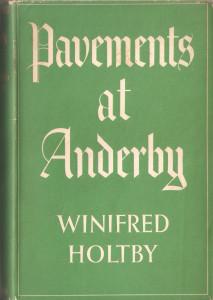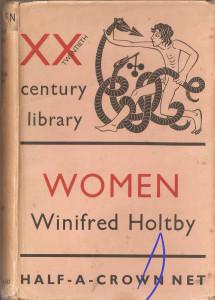Book Review by Chris Hopkins.
This short feminist dystopia by Winifred Holtby is, as far as I can see, completely forgotten about, but well-worth recovering. It dates from 1930 and was then published in 1937 (after Holtby’s early death in 1935) in a collection called The Pavements at Anderby (Collins, London, 1937). This volume, edited by her friends H.S. Reid and Vera Brittain, collected thirty short stories found among Holtby’s papers, which had mainly been published solely in magazines or were unpublished. (1) Though I was reading the volume as part of a vow (uncompleted as yet) to read all the unread books in my waiting-pile while under lockdown, I was very struck by this dystopian story which coincided nicely with our May reading topic, and which certainly still has significant resonances.

The story has an unnamed first-person narrator, who slips us swiftly into a society separated geographically and ideologically from a future time’s mainstream. The story opens strikingly thus:
For many years I had been eager to visit the Island. Nobody interested in social history could fail to be allured by a community which until the first half of the twentieth century had followed the main tendencies of European culture, and then suddenly broken away. The change began, I knew, with Madame Mollard’s League of True Womanhood, and the conversion of the Islanders to the theory of the Absolute Inequality of the Sexes, just at the period when most of us were beginning to emphasize the importance of human characteristics and the comparative unimportance of sexual differentiation. (2)
Her hostess on the Island has kindly left by her bedside ‘a copy of Morena Mollard’s own masterpiece, The Inequality of the Sexes’. As is usually the case in dystopias, there is a narrative device enabling a reasonably systematic description of the origins of this nightmare alternative to the present (or rather a heightening of already latent possibilities within that present). Here the account is given by a surviving witness of the historical events which transformed the Island’s society into its current peculiar form.
The witness is Madame Ralleen, a respected vice-president of the League of True Womanhood, and since she is getting frail, she wants to tell a story which only she knows to an outsider who will do no harm with that knowledge. It is the story of a woman called Anne Parthanolia and her part in what Madame Ralleen labels a dreadful failure on the Island. Fifty years ago, we are told there was on the Island something calling itself ‘a Humanist movement’, which was influential. Its members believed that:
When either a man or a woman added two and two, the sum came to four, that when a woman performed an operation, or made a chair, or designed an engine, it had the same result as though a man had done it, and so on. It was very odd that anybody could be persuaded to believe such doctrines; but at the time they had a great effect. (p.235)
Not everyone believed in this kind of thing, and some counter-movements grew up to fight against such outrageous untruth. A female leader of this opposition, called Morena Mollard, emerged. She has been educated in a Humanist college and enjoys many of the benefits of Humanism, ‘smoking, and earning a substantial salary, and speaking in public, and looking up her own trains in a timetable’ (pp.236-7). But a key aspect of Humanist doctrine bothers her greatly: ‘if everybody, even poor women, shared with her an equal humanity, what excuse had she to exercise authority over them?’ (p.237). Equality of gender and of class does not appeal to her. In a dream she has a realisation that she alone has been singled out to exercise female power, and that she must do that by defeating the Humanists and reconverting all other women to a true sense of their own inequality. Many men are very keen to support Madame Mollard too – and establish funds to pay her an enormous salary to enable her to work full-time on her vocation. She works ceaselessly to dissuade the people of the Island from belief in the nonsense of equality. She is very successful – women, and especially those in less privileged positions, begin to see that they could never be as strong, as persuasive, as indefatigable as Madame Mollard and therefore it must be true that, with her as sole exception, women were not meant to seek equality nor take part in public life nor ask to be paid for their work.
The Humanists were not completely prohibited, but the mass of women and men adopt the truth established by Madam Mollard as leader of the League of True Womanhood. One Humanist activist is very angry, however, partly because she does not match any of the now possible types of (essentially subjugated) women. It is not that she is strong or even good at anything (in fact everything she attempts goes wrong), but that the Humanist view of women and men gives her at least the possibility of being a person, a human. This, of course, is Anne Parthanolia. She is finally driven to act after being humiliated by Madame Mollard at a public debate on the question, ‘Have Women Physical Stamina’? Anne, acting as steward, unfortunately faints in public, helping Mollard to win the debate. From then on, Mollard uses Anne as an example of the impossibility of Humanist belief in equality. Anne decides to poison Mollard with digitalis at a banquet in order to expiate her weakness in letting Humanism down by fainting, and to defeat the League. Her crime is never discovered, for it is assumed that Madame Mollard, who is exceptionally large and imposing, has indeed had a heart attack.
Sadly though, as Madam Ralleen explains, even here Anne again fails, for the League took over completely:
[Mollard’s] ‘early death proved so conclusively her own contention that women – even exceptional women like herself – are too fragile for any continued strain. As you see to-day, the whole island has been converted to her doctrine, and she is worshipped as a saint’ (p.243).
The first-person narrator asks what happened to Anne Parthanolia. Of course, Madam Ralleen is Anne – defeated, she has faded into obscurity. Then, passing as a Mollardian, she marries a man who believes keenly in inequality, and has to live with the knowledge that she has unintentionally assured the triumph of the doctrine of the absolute inequality of the sexes:
She nodded, chuckling. ‘I sometimes wonder whether the Mollardians who made me a vice-president of the League of True Womanhood have the slightest idea of the real debt they owe me.’ (p.245)
Holtby was a member of the Six Point Group which campaigned for six specific feminist legal reforms. (3) She would also be very aware that British women had only universally had the vote since 1928, and that access to many arenas, and equality under law were still very far from achieved. (4) Of course, her alternative reality had a firm existence in actuality, as it still does, with some individuals, some cultures and some political groups believing firmly in absolute inequality. Mussolini had been in power in Italy since 1922, and Italian Fascism had a highly essentialist ideology of gender, as did Hitler’s Nazism. Holtby wrote acutely about the challenges posed to progress towards gender equality by Fascism and Nazism in her excellent 1935 non-fiction book, Women and a Changing Civilisation (Bodley Head, London, 1934), but she was clearly thinking even in 1930 about embedded obstacles to rethinking gendered ideologies.
We are probably more used to thinking of Holtby in relation to the realism of South Riding (1936), but this short story collection shows her considerable interest in both historical and futuristic fiction of various kinds. This story is very much a fable in form, and uses its narrative devices nicely to construct a partly-satirical dystopian vision which was (and is) amusing, but is still of great weight. It ridicules an irrational belief, or investment in privilege, on which we need to continue to keep a close eye. Holtby once gave some advice particularly addressed to women writers, which included her view that: ‘You are writing for entertainment, but a certain amount of instruction must always be there.’ (5) This story is a good example of her putting that advice into practice.

Note 1. There is no editorial apparatus to record which were published and where, and which were unpublished.
Note 2. Second impression, January 1938, p.233. All subsequent references are to this edition and will be given in the text.
Note 3. See Wikipedia entry: https://en.wikipedia.org/wiki/Six_Point_Group
Note 4. See Wikipedia entry: https://en.wikipedia.org/wiki/Representation_of_the_People_(Equal_Franchise)_Act_1928
Note 5. Quoted by Berry, Paul and Marion Shaw (eds) in Remember, Remember! The Selected Stories of Winifred Holtby, London: Virago, 1999, Introduction, p. xii. My apologies that this is not a full reference, giving the date and place of Holtby’s remarks – my copy of the book is currently locked down in my office. I’ll correct it when I can!
